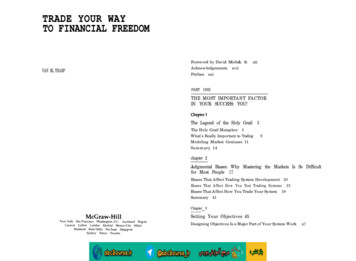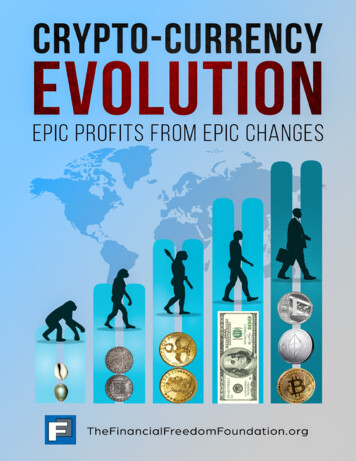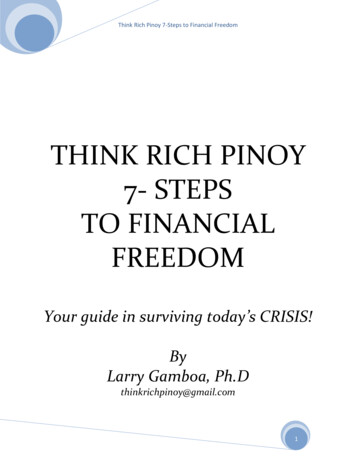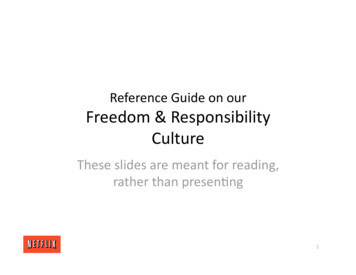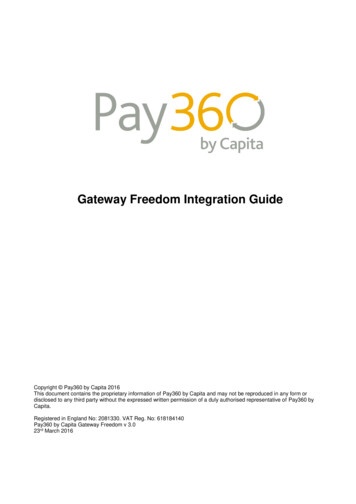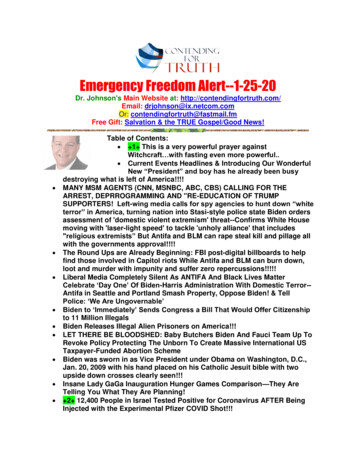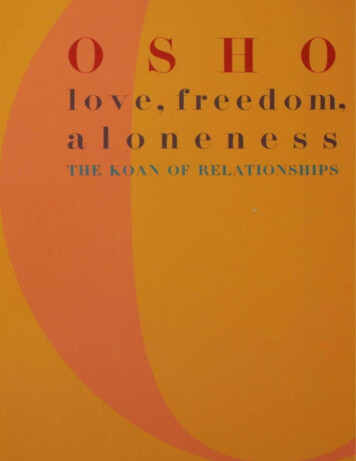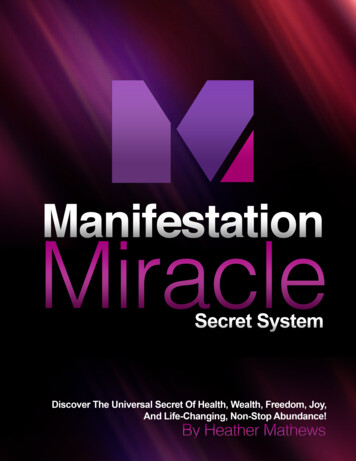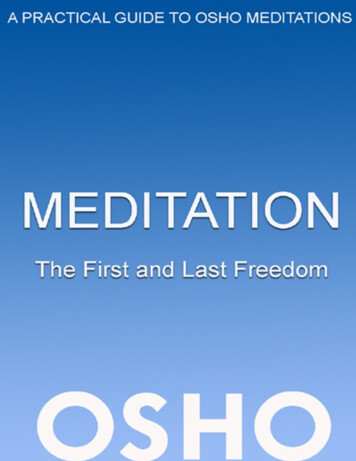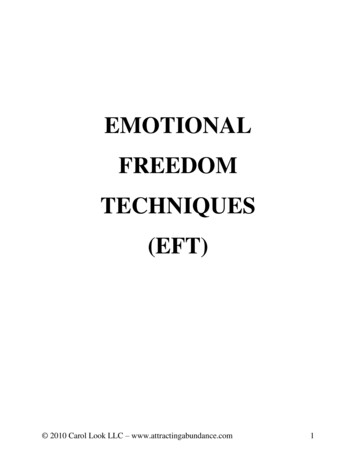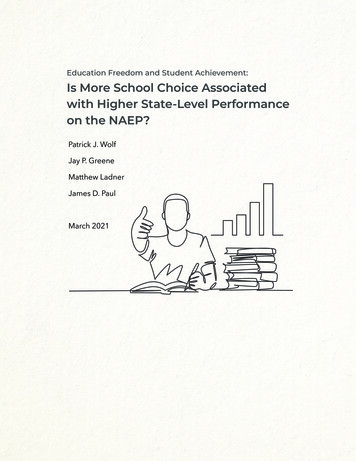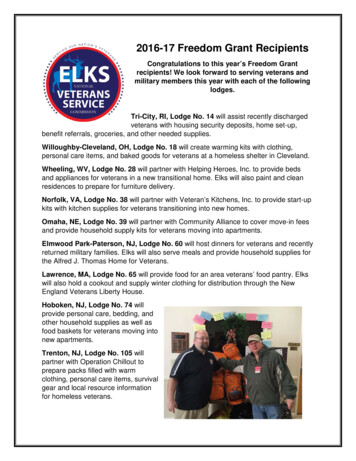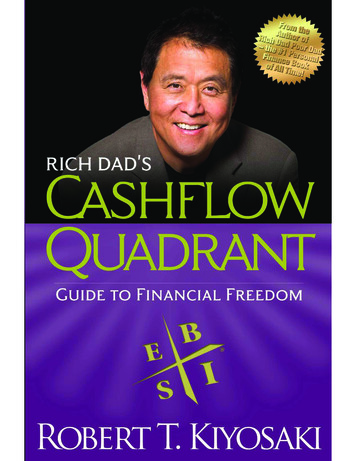
Transcription
i
Rich Dad'sCashflowquadrantGuide to Financial FreedomBy Robert T. Kiyosaki
Rich Dad'sCashflowquadrantGuide to Financial FreedomBy Robert T. Kiyosaki
If you purchase this book without a cover, or purchase a PDF, jpg, or tiff copy of this book,it is likely stolen property or a counterfeit. In that case, neither the authors, the publisher,nor any of their employees or agents has received any payment for the copy. Furthermore,counterfeiting is a known avenue of financial support for organized crime and terroristgroups. We urge you to please not purchase any such copy and to report any instance ofsomeone selling such copies to Plata Publishing LLC.This publication is designed to provide competent and reliable information regarding thesubject matter covered. However, it is sold with the understanding that the author andpublisher are not engaged in rendering legal, financial, or other professional advice. Lawsand practices often vary from state to state and country to country and if legal or otherexpert assistance is required, the services of a professional should be sought. The author andpublisher specifically disclaim any liability that is incurred from the use or application ofthe contents of this book.Copyright 1998, 2012 by Robert T. Kiyosaki. All rights reserved. Except as permittedunder the U.S. Copyright Act of 1976, no part of this publication may be reproduced,distributed, or transmitted in any form or by any means or stored in a database or retrievalsystem, without the prior written permission of the publisher.Published by Plata Publishing, LLCCASHFLOW, Rich Dad, and CASHFLOW Quadrant are registered trademarks ofCASHFLOW Technologies, Inc.is a registered trademark ofCASHFLOW Technologies, Inc.Plata Publishing, LLC4330 N. Civic Center PlazaSuite 100Scottsdale, AZ 85251(480) 998-6971Visit our websites: PlataPublishing.com and RichDad.comPrinted in the United States of AmericaFirst Edition: 1998First Plata Publishing Edition: August 2011ISBN: 978-1-61268-005-7Cover photo credit: Seymour & Brody Studio
Other Best-selling Booksby Robert T. KiyosakiRich Dad Poor DadWhat the Rich Teach Their Kids About Money –That the Poor and Middle Class Do NotRich Dad’s Guide to InvestingWhat the Rich Invest in That the Poor and Middle Class Do NotRich Dad’s Rich Kid Smart KidGive Your Child a Financial Head StartRich Dad’s Retire Young Retire RichHow to Get Rich Quickly and Stay Rich ForeverRich Dad’s ProphecyWhy the Biggest Stock Market Crash in History Is Still Coming.And How You Can Prepare Yourself and Profit from It!Rich Dad’s Success StoriesReal-Life Success Stories from Real-Life PeopleWho Followed the Rich Dad LessonsRich Dad’s Guide to Becoming RichWithout Cutting Up Your Credit CardsTurn Bad Debt into Good DebtRich Dad’s Who Took My Money?Why Slow Investors Lose and Fast Money Wins!Rich Dad Poor Dad for TeensThe Secrets About Money – That You Don’t Learn In School!Rich Dad’s Escape from the Rat RaceHow to Become a Rich Kid by Following Rich Dad’s AdviceRich Dad’s Before You Quit Your JobTen Real-Life Lessons Every Entrepreneur Should KnowAbout Building a Multimillion-Dollar BusinessRich Dad’s Increase Your Financial IQGet Smarter with Your MoneyConspiracy of the RichThe 8 New Rules of MoneyUnfair AdvantageThe Power of Financial Education
My rich dad used to say,“You can never have true freedom without financial freedom.”He would go on to say,“Freedom may be free, but it has a price.”This book is dedicated to those who are willing to pay the price.viii
Editor’s NoteThe Times They Are A-Changin’There have been many changes in our economy and the investinglandscape since Rich Dad Poor Dad was first published in 1997. Fourteenyears ago, Robert Kiyosaki challenged conventional wisdom with hisbold statement that “your house is not an asset.” His contrarian views onmoney and investing were met with skepticism, criticism, and outrage.In 2002, Robert’s book, Rich Dad’s Prophecy, advised that we prepare foran upcoming financial market crash. In 2006, Robert joined forces withDonald Trump to write Why We Want You To Be Rich, a book inspired bytheir concern for the shrinking middle class in America.Robert continues to be a passionate advocate for the importance andpower of financial education. Today, in the wake of the subprime fiasco,record home foreclosures, and a global economic meltdown that isstill raging, his words seem not only prophetic, but enlightened. Manyskeptics have become believers.In preparing the 2011 edition of Rich Dad’s CASHFLOW Quadrant, Robertrealized two things: that his message and teachings have withstood the testof time, and that the investment landscape, the world in which investorsoperate, has changed dramatically. These changes have affected, and willcontinue to affect, those in the I (Investor) quadrant and have fueledRobert’s decision to update an important section in this book—ChapterFive: The Five Levels of Investors.x
AcknowledgmentsThe phenomenal success of Rich Dad Poor Dad has broughtmillions of new friends from all over the world.Their kind words and friendship—and their amazing stories ofperseverance, passion, and success in applying the Rich Dad principlesto their lives—inspired me to write this book:Rich Dad’s CASHFLOW QuadrantGuide to Financial FreedomSo to my friends, old and new, for their enthusiastic support beyondmy wildest dreams, I say thank you.xii
ContentsINTRODUCTIONWhich Quadrant Are You In? . 1Part OneThe CASHFLOW QuadrantChapter OneWhy Don’t You Get a Job? . 11Chapter TwoDifferent Quadrants, Different People . 23Chapter ThreeWhy People Choose Security over Freedom . 57Chapter FourThe Three Kinds of Business Systems . 81Chapter FiveThe Five Levels of Investors . 95Chapter SixYou Cannot See Money with Your Eyes . 119Part TwoBringing Out the Best in YouChapter SevenBecoming Who You Are . 149Chapter EightHow Do I Get Rich?. 165Chapter NineBe the Bank, Not the Banker . 187Part ThreeHow To Become a Successful B and IChapter TenTake Baby Steps . 217THE SEVEN STEPS TO FINDING YOUR FINANCIAL FAST TRACKChapter ElevenStep 1: It’s Time to Mind Your Own Business . 233Chapter TwelveStep 2: Take Control of Your Cash Flow . 239Chapter Thirteen Step 3: Know the Difference Between Risk and Risky . 247Chapter Fourteen Step 4: Decide What Kind of Investor You Want to Be . 251Chapter FifteenStep 5: Seek Mentors . 259Chapter SixteenStep 6: Make Disappointment Your Strength . 269Chapter Seventeen Step 7: The Power of Faith . 275Chapter Eighteen In Summary. 281
PrefaceWHAT IS YOURLIFE'S GOAL?“What do you want to be when you grow up?” That is a questionmost of us have been asked.I had many interests as a kid, and it was easy to choose. If itsounded exciting and glamorous, I wanted to do it. I wanted to be amarine biologist, an astronaut, a Marine, a ship’s officer, a pilot, anda professional football player.I was fortunate enough to achieve three of those goals: a MarineCorps officer, a ship’s officer, and a pilot.I knew I did not want to become a teacher, a writer, or an accountant.I did not want to be a teacher because I did not like school. I did notwant to be a writer because I failed English twice. And I dropped out ofmy MBA program because I could not stand accounting.Ironically, now that I have grown up, I have become everythingI never wanted to become. Although I disliked school, today I own aneducation company. I personally teach around the world because I loveteaching. Although I failed English twice because I could not write,today I am best known as an author. My book, Rich Dad Poor Dad, wason the New York Times best-sellers list for over seven years and is oneof the top three best-selling books in the United States The only booksahead of it are The Joy of Sex and The Road Less Traveled. Adding onemore irony, Rich Dad Poor Dad and my CASHFLOW board game are abook and a game about accounting, another subject I struggled with.So what does this have to do with the question: “What is your goalin life?”xvi
PrefaceThe answer is found in the simple, yet profound, statement bya Vietnamese monk, Thich Naht Hahn: “The path is the goal.” Inother words, finding your path in life is your goal in life. Your path isnot your profession, how much money you make, your title, or yoursuccesses and failures.Finding your path means finding out what you were put here onthis earth to do. What is your life’s purpose? Why were you given thisgift called life? And what is the gift you give back to life?Looking back, I know going to school was not about finding mylife’s path. I spent four years in military school, studying and trainingto be a ship’s officer. If I had made a career sailing for Standard Oilon their oil tankers, I would never have found my life’s path. If I hadstayed in the Marines or had gone to fly for the airlines, I would neverhave found my life’s path.Had I continued on as a ship’s officer or become an airline pilot,I would never have become an international best-selling author,been a guest on the Oprah show, written a book with DonaldTrump, or started an international education company that teachesentrepreneurship and investing throughout the world.Finding Your PathThis CASHFLOW Quadrant book is important because it is aboutfinding your path in life. As you know, most people are programmedearly in life to “Go to school and get a job.” School is about finding ajob in the E or S quadrant. It is not about finding your life’s path.I realize there are people who know exactly what they are going todo early in life. They grow up knowing they are going to be a doctor,lawyer, musician, golfer or actor. We have all heard about childprodigies, kids with exceptional talents. Yet you may notice, these areprofessions, not necessarily a life’s path.xvii
CASHFLOW QuadrantSo How Does One Find Their Path in Life?My answer is: I wish I knew. If I could wave my magic wand andyour life’s path would magically appear, I would.Since I do not have a magic wand nor can I tell you what to do,the best thing I can do is tell you what I did. And what I did was trustmy intuition, my heart, and my guts. For example, in 1973, returningfrom the war, when my poor dad suggested I go back to school, get myhigher degrees, and work for the government, my brain went numb,my heart went heavy and my gut said, “No way.”When he suggested I get my old job back with Standard Oil or flyfor the airlines, again my mind, heart, and gut said no. I knew I wasthrough sailing and flying, although they were great professions andthe pay was pretty good.In 1973 at the age of 26, I was growing up. I had followed myparent’s advice and gone to school, received my college degree, and hadtwo professions: a license to be a ship’s officer and a license to fly. Theproblem was, they were professions and the dreams of a child.At the age of 26, I was old enough to know that education is a process.For example, when I wanted to be a ship’s officer, I went to a school thatturned out ships’ officers. And when I wanted to learn to fly, I went toNavy flight school, a two-year process that turns non-pilots into pilots.I was cautious about my next educational process. I wanted to know whatI was going to become before I started my next educational process.Traditional schools had been good to me. I had achieved mychildhood professions. Reaching adulthood was confusing becausethere were no signs saying, “This is the way.” I knew what I didn’t wantto do, but I did not know what I wanted to do.It would have been simple if all I wanted was a new profession.If I had wanted to be a medical doctor, I would have gone to medicalschool. If I had wanted to be a lawyer, I would have gone to lawschool. But I knew there was more to life than just going to school togain another professional credential.I did not realize it at the time, but at 26 years of age, I was nowlooking for my path in life, not my next profession.xviii
PrefaceA Different EducationIn 1973, in my last year of active duty flying for the MarineCorps when I was stationed near home in Hawaii, I knew I wantedto follow in my rich dad’s footsteps. While in the Marines, I signedup for real estate courses and business courses on the weekends,preparing to become an entrepreneur in the B and I quadrants.At the same time, upon a friend’s recommendation of a friend,I signed up for a personal-development course, hoping to find outwho I really was. A personal-development course is non-traditionaleducation because I was not taking it for credits or grades. I did notknow what I was going to learn, as I did when I signed up for realestate courses. All I knew was that it was time to take courses to findout about me.In my first weekend course, the instructor drew this simplediagram on the flip chart:PHYSICALMENTALEMOTIONALSPIRITUALxix
CASHFLOW QuadrantWith the diagram complete, the instructor turned and said,“To develop into a whole human being, we need mental, physical,emotional, and spiritual education.”Listening to her explanation, it was clear to me that traditionalschools were primarily about developing students mentally. That iswhy so many students who do well in school, do not do well in reallife, especially in the world of money.As the course progressed over the weekend,
By Robert T. Kiyosaki Cashflow quadrant Rich Dad's If you purchase this book without a cover, or purchase a PDF, jpg, or tiff copy of this book, it is likely stolen property or a counterfeit. In that case, neither the authors, the publisher, nor any of their employees or agents has received any payment for the copy. Furthermore, counterfeiting is a known avenue of financial support for .
